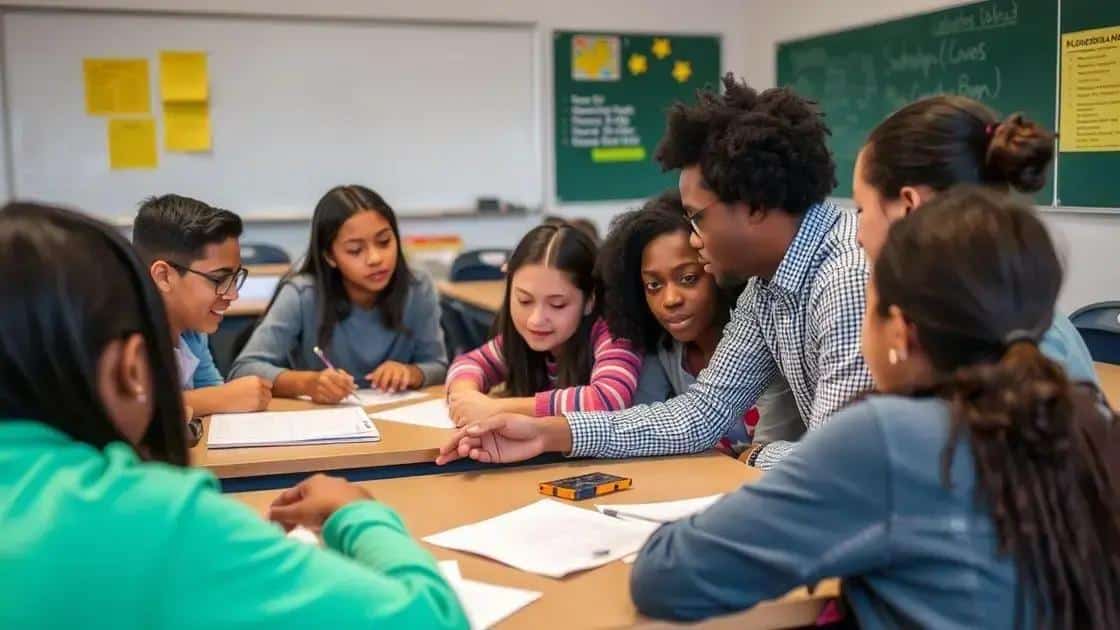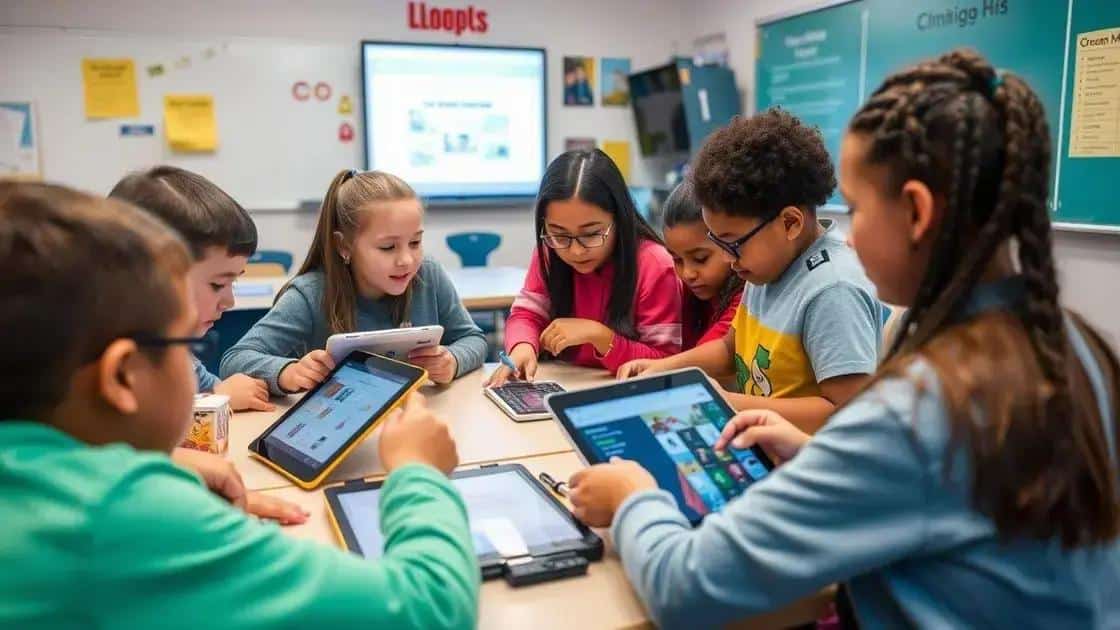Wish curriculum improvement ideas to enhance learning

Evaluating curriculum effectiveness and outcomes involves analyzing data, gathering feedback, and conducting regular reviews to ensure educational programs meet student needs and enhance learning experiences.
Wish curriculum improvement ideas can significantly enhance the educational experience for both students and educators. Imagine a learning environment where every student thrives! In this article, we will delve into practical strategies that can transform your curriculum.
Identifying curriculum gaps and deficiencies
Identifying curriculum gaps and deficiencies is crucial for enhancing educational programs. Schools must regularly evaluate their curricula to ensure they meet the needs of students. This process involves looking closely at material, teaching methods, and student outcomes.
One effective way to identify gaps is through student feedback. Asking students about their learning experiences can provide valuable insights. Teachers should also discuss their observations to pinpoint areas needing improvement.
Data Analysis
Analyzing performance data helps in revealing gaps in understanding. Standardized test scores can show which areas students struggle with the most. Additionally, assessment results provide a clear picture of learning deficiencies.
- Look for patterns in test scores.
- Compare performance across different student groups.
- Evaluate classroom participation and engagement levels.
Moreover, comparing your curriculum to state standards can highlight areas where it may fall short. Schools should align their content with these benchmarks to ensure comprehensive education.
Curriculum Review Committees
Establishing curriculum review committees can foster a collaborative environment for identifying deficiencies. These committees, consisting of educators, administrators, and even parents, can gather diverse perspectives. By working together, they can assess the curriculum’s effectiveness and relevance.
Regular meetings and workshops, along with reviewing curriculum guides and resources, can enhance this process. Moreover, involving students in discussions can provide even greater insights into their needs.
Innovative teaching methods to engage students
Innovative teaching methods to engage students are essential for creating a vibrant learning environment. These approaches can motivate students and make learning more enjoyable. Teachers are constantly seeking ways to make lessons interactive and effective.
One popular method is project-based learning, which allows students to work on real-world problems. This hands-on approach encourages critical thinking and teamwork. When students collaborate on projects, they engage deeply with the material and develop valuable skills.
Technology Integration
Integrating technology into the classroom is another effective way to engage students. Utilizing tools like interactive whiteboards, tablets, and educational apps can make lessons more dynamic. For example, using educational games can help reinforce concepts in a fun way.
- Encourage students to use online resources for research.
- Use multimedia presentations to enhance learning.
- Incorporate virtual reality to experience historical events.
Another innovative method is the flipped classroom approach. In this model, students learn new content at home through videos or readings, then apply what they learned in class through discussions and hands-on activities. This technique fosters a more active learning environment and allows teachers to focus on students’ needs.
Social and Emotional Learning
Focusing on social and emotional learning (SEL) can also enhance student engagement. Teaching students to manage their emotions and develop empathy makes the classroom a more supportive space. <SEL programs can include group discussions, role-playing, and other activities to build connections and understanding among students.
Creating a classroom culture that values student input can further enhance engagement. Teachers can invite students to share ideas and lead discussions. When students feel valued and heard, they are more likely to participate actively in their education.
Incorporating technology in curriculum design

Incorporating technology in curriculum design can significantly enhance learning experiences for students. Today, students are digital natives, and using technology can bridge the gap between traditional learning and modern needs.
One effective approach is to integrate multimedia resources into lessons. By using videos, podcasts, and online articles, teachers can make complex subjects more engaging. For instance, a historical event can come alive through a documentary, or a scientific concept can be better understood with an animated simulation.
Blended Learning
Blended learning combines face-to-face instruction with online components. This approach gives students more flexibility and control over their learning pace. Instructors can assign online courses that students complete at home, followed by in-class discussions to reinforce understanding.
- Use online quizzes to assess knowledge.
- Provide resources through learning management systems.
- Engage students in virtual group projects.
Moreover, incorporating educational apps can add an interactive element to the curriculum. Apps designed for specific subjects can offer personalized learning experiences. For example, math apps can adjust difficulty levels based on individual student performance, making learning tailored and efficient.
Collaboration Tools
Utilizing collaboration tools is essential for developing teamwork skills in students. Platforms like Google Classroom or Microsoft Teams enable students to work together on projects seamlessly. Sharing documents and resources in real-time fosters a sense of community, even in a digital environment.
Interactive whiteboards are another way to effectively incorporate technology. These boards can display lessons, engage students in active discussions, and allow for live polling, enhancing participation. Additionally, they make it easier to visualize data and other information for better comprehension.
Developing inclusive and diverse curricula
Developing inclusive and diverse curricula is essential for fostering a learning environment where all students feel valued. An inclusive curriculum reflects a variety of perspectives, cultures, and backgrounds, which can enhance student engagement and understanding.
To create an inclusive curriculum, it is important to include multicultural education. This means integrating content that represents different cultures, histories, and contributions. For instance, lessons on historical events should consider the perspectives of various groups affected, helping students appreciate diversity.
Student Voice and Choice
Incorporating student voice is another key aspect of developing a diverse curriculum. Teachers can gather input from students on topics they are passionate about. Allowing students to choose projects that resonate with their interests can lead to deeper learning and investment in their education.
- Include literature from diverse authors.
- Integrate global issues into discussions.
- Encourage collaboration among students from different backgrounds.
Another important strategy is to utilize differentiated instruction. This method allows educators to tailor lessons to meet varying learning styles and needs. For example, some students may benefit from hands-on activities, while others may prefer visual aids or group discussions. By offering multiple ways to engage with content, teachers can better support all learners.
Promoting Equity in Education
Promoting equity in education involves recognizing and addressing systemic barriers that may affect student learning. Teachers should be aware of each student’s unique challenges and strengths. Regular assessments can help identify areas where students may need additional support or resources.
Additionally, professional development for educators is crucial in creating inclusive curricula. Training can focus on cultural competency, anti-bias education, and effective strategies for teaching diverse student populations. When teachers are equipped with the right tools, they can create classrooms that celebrate differences and promote understanding.
Evaluating curriculum effectiveness and outcomes
Evaluating curriculum effectiveness and outcomes is vital for understanding how well educational programs are meeting student needs. Schools must regularly assess various aspects of their curricula to ensure they promote learning and development.
One key method of evaluation is through data analysis. Schools can collect data from standardized tests, classroom assessments, and student feedback. Analyzing this information helps educators identify strengths and weaknesses in their curriculum.
Gathering Feedback
Gathering feedback from students and teachers is also critical. Surveys and focus groups can provide insights into how engaging and effective the curriculum is. This feedback should be taken seriously, as it can highlight areas that need improvement and inform necessary changes.
- Use anonymous surveys to collect honest feedback.
- Conduct regular meetings with teachers to discuss curriculum challenges.
- Engage parents and community members for broader perspectives.
Another effective approach is to implement periodic reviews. Schools can create a schedule that allows them to review different subjects and grade levels systematically. This structured review process ensures continual improvement and accountability.
Setting Clear Objectives
Establishing clear learning objectives is essential in evaluating curriculum effectiveness. Teachers should align their lessons with specific goals that are measurable. This alignment makes it easier to assess whether students are meeting the expected outcomes.
Once objectives are set, educators can use various assessment methods to measure progress. These may include quizzes, projects, and presentations. The results from these assessments provide valuable information on how well the curriculum is working.
FAQ – Questions about Evaluating Curriculum Effectiveness
Why is it important to evaluate curriculum effectiveness?
Evaluating curriculum effectiveness helps schools ensure that educational programs meet student needs and improve learning outcomes.
What methods can be used for evaluating curriculum?
Common methods include data analysis from assessments, gathering feedback from students and teachers, and conducting regular curriculum reviews.
How often should curriculum evaluations occur?
Curriculum evaluations should be conducted regularly, ideally on a systematic schedule to ensure continual improvement.
What role does student feedback play in curriculum evaluation?
Student feedback provides valuable insights into what works and what doesn’t, helping educators refine their teaching strategies for better engagement.





